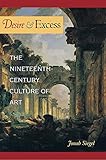Desire and Excess : The Nineteenth-Century Culture of Art / Jonah Siegel.
Material type: TextPublisher: Princeton, NJ : Princeton University Press, [2022]Copyright date: ©2000Description: 1 online resource (328 p.) : 54 halftonesContent type:
TextPublisher: Princeton, NJ : Princeton University Press, [2022]Copyright date: ©2000Description: 1 online resource (328 p.) : 54 halftonesContent type: - 9781400849826
- Art and literature -- History -- 19th century
- Artists -- History -- 19th century
- Arts, Modern -- 19th century -- Historiography
- ART / History / General
- Adorno, Theodor
- Albert Memorial
- Altick, Richard
- Appreciations (Pater)
- Audran, Girard
- Aurora Leigh (Browning)
- Ballantyne, John
- Beckett, Samuel
- Benjamin, Walter
- Bloom, Harold
- Bourdieu, Pierre
- British Institute
- Cafarelli, Annette
- Cartoons (Raphael)
- Chartier, Roger
- Cockerell, Charles
- Constable, Archibald
- Crystal Palace
- Darwin, Charles
- Delaroche, Paul
- Dickens, Charles
- Dying Gladiator
- Ellmann, Maud
- Elysium (Barry)
- Farnese Hercules
- Flaubert, Gustave
- Fra Angelico
- Gadamer, Hans-Georg
- Gould, Cecil
- Guillory, John
- Haydon, Robert
- Heidegger, Martin
- Hibbert, Christopher
- Iliad (Homer)
- Indicator
- Ingres
- Isabella (Keats)
- Johnson, Edgar
- Joyce, James
- Kendrick, Walter
- Lamarque, Peter
- Levey, Michael
- Lives of the Artists (Vasari)
- Lowth, Robert
- Masson, David
- Menzies, William
- Nadel, Ira
- Newton, Charles
- Nibelungenlied
- Oldfield, Edmund
- Ossian
- artworld concept
- 709.034 21
- NX454
- NX454
- online - DeGruyter
| Item type | Current library | Call number | URL | Status | Notes | Barcode | |
|---|---|---|---|---|---|---|---|
 eBook
eBook
|
Biblioteca "Angelicum" Pont. Univ. S.Tommaso d'Aquino Nuvola online | online - DeGruyter (Browse shelf(Opens below)) | Online access | Not for loan (Accesso limitato) | Accesso per gli utenti autorizzati / Access for authorized users | (dgr)9781400849826 |
Browsing Biblioteca "Angelicum" Pont. Univ. S.Tommaso d'Aquino shelves, Shelving location: Nuvola online Close shelf browser (Hides shelf browser)

|

|

|

|

|

|

|
||
| online - DeGruyter Anatomy of Satire / | online - DeGruyter Calendar of the Roman Republic / | online - DeGruyter Roman Rule in Asia Minor, Volume 1 (Text) : To the End of the Third Century After Christ / | online - DeGruyter Desire and Excess : The Nineteenth-Century Culture of Art / | online - DeGruyter The Fortunes of Apuleius and the Golden Ass : A Study in Transmission and Reception / | online - DeGruyter Cultures in Motion / | online - DeGruyter Dictionary of Untranslatables : A Philosophical Lexicon / |
Frontmatter -- CONTENTS -- LIST OF FIGURES -- ACKNOWLEDGEMENTS -- PREFACE. The Apparent Permanence of the Museum as Against Its Actual Permanence: The Nineteenth-Century Culture of Art -- Introduction. The Museum as Mortuary -- PART ONE: ART IN THE MUSEUM: ARTIST AND FRAGMENT AT THE TURN OF THE NINETEENTH CENTURY -- PART TWO: THE AUTHOR AS WORK OF ART ACCUMULATION, DISPLAY, AND DEATH IN LITERARY BIOGRAPHY -- PART THREE: ABSENCE AND EXCESS: THE PRESENCE OF THE OBJECT -- PART FOUR: THE DEATHS OF THE CRITICS -- AFTERWORD. LAS MENINAS AS COVER: FOUCAULT, VELAZQUEZ, AND THE REFLECTION OF THE MUSEUM -- NOTES -- ILLUSTRATION CREDITS -- INDEX
restricted access online access with authorization star
http://purl.org/coar/access_right/c_16ec
In this fascinating look at the creative power of institutions, Jonah Siegel explores the rise of the modern idea of the artist in the nineteenth century, a period that also witnessed the emergence of the museum and the professional critic. Treating these developments as interrelated, he analyzes both visual material and literary texts to portray a culture in which art came to be thought of in powerful new ways. Ultimately, Siegel shows that artistic controversies commonly associated with the self-consciously radical movements of modernism and postmodernism have their roots in a dynamic era unfairly characterized as staid, self-satisfied, and stable.The nineteenth century has been called the Age of the Museum, and yet critics, art theorists, and poets during this period grappled with the question of whether the proliferation of museums might lead to the death of Art itself. Did the assembly and display of works of art help the viewer to understand them or did it numb the senses? How was the contemporary artist to respond to the vast storehouses of art from disparate nations and periods that came to proliferate in this era?Siegel presents a lively discussion of the shock experienced by neoclassical artists troubled by remains of antiquity that were trivial or even obscene, as well as the anxious aesthetic reveries of nineteenth-century art lovers overwhelmed by the quantity of objects quickly crowding museums and exhibition halls. In so doing, he illuminates the fruitful crises provoked when the longing for admired art is suddenly satisfied. Drawing upon neoclassical art and theory, biographies of early nineteenth-century writers including Keats and Scott, and the writings of art critics such as Hazlitt, Ruskin, and Wilde, this book reproduces a cultural matrix that brings to life the artistic passions and anxieties of an entire era.
Mode of access: Internet via World Wide Web.
In English.
Description based on online resource; title from PDF title page (publisher's Web site, viewed 29. Jun 2022)


